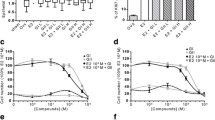Abstract
We have found that ginsenoside Rc and Re induce c-fos in MCF-7 human breast carcinoma cells at both the mRNA and protein levels. However, neither ginsenoside activated the expression of reporter gene under the control of AP-1/TPA response elements. We have also examined the possibility that ginsenoside Rc and Re act by binding to intracellular steroid hormone receptors that act as transcriptional factors in the nucleus in inducing c-fos mRNA in MCF7 human breast carcinoma cells. However, ginsenoside Rc and Re did not bind to glucocorticoid, androgen, estrogen, or retinoic acid receptors as examined by the transcription activation of the luciferase reporter genes in CV-1 cells that were transiently transfected with the corresponding steroid hormone receptors and hormone responsive luciferase reporter plasmids. These data demonstrate that ginsenoside Rc and Re act via other transcription factors and not via estrogen receptor in c-Fos expression.
Similar content being viewed by others
References
Amato, P., Christophe, S., and Mellon, P. L., Estrogenic activity of herbs commonly used as remedies for menopausal symptoms.Menopause, 9, 145–150 (2002).
Attele, A. S., Wu, J. A., and Yuan, C. S., Ginseng pharmacology: Multiple constituents and multiple actions.Biochem. Pharmacal., 58, 1685–1693 (1999).
Bhattaacharya, S. K. and Mitra, S. K., Anxiolytic activity of panax ginseng roots: an experimental study.J. Ethnopharmacol., 34, 87–92 (1991).
Chung, E., Lee, K. Y., Lee, Y. J., Lee, Y. H., and Lee, S. K., Ginsenoside-Rg1 down-regulates glucocorticoid receptor and displays synergistic effects with cAMP.Steroids, 63, 421–424 (1998).
Lee, H. C. and Edwards, M. A., Stimulation of DNA synthesis andc-tos mRNA expression in primary rat hepatocytes by estrogen.Carcinogenesis, 22, 1437–1481 (2001).
Duan, R., Xie, W., Burghardt, R. C., and Safe, S., Estrogen Receptor-mediated Activation of the Senum Response Element in MCF-7 Cells through MAPK-dependent phosphorylation of Elk-1.J. Biol. Chem., 276, 11590–11598 (2001).
Duda, R. B., Zhong, Y. Z., Navas, V., Li, M. Z. C., Toy, B. R., and Alavarez, J. G., American Ginseng and Breast Cancer Therapeutic Agents Synergistically Inhibit MCF-7 Breast Cancer Cell Growth.J. Surg. Oncol., 72, 230–239 (1999).
Gehm, B. D., McAndrews, J. M., Chien, P. Y., and Jameson, J. L., Resveratrol, a polyphenolic compound found in grapes and wine, is an agonist for the estrogen receptor.Proc. Natl. Acad. Sci. USA, 94, 14138–14143 (1997).
Goldstein, B., Ginseng: Its history, dispersion and folk tradition.Am. J. Chin. Med., 3, 223–234 (1975).
Gillis, C. N.,Panax ginseng Phamacology: A Nitric Oxide Link?Biochem. Pharmacol., 54, 1–8 (1997).
Klein-Hitpass, L., Schorpp, M., Wagner, U., and Ryffel, G. U., An estrogen-responsive element derived from the 5′ flanking region of Xenopus vitellogenin A2 gene functions in transfected human cells.Cell, 46, 1053–1061 (1986).
Liu, C. X. and Xiao, P. G., Recent advances on ginseng research in China.J. Ethnopharmacol., 36, 27–38 (1992).
Liu, W. K., Xu, S. X., and Che, C. T., Anti-proliferative effect of ginseng saponins on human prostate cancer cell line.Life Sci., 67, 1297–1306 (2000).
Mercier, G., Turque, N., and Schumacher, M., Rapid Effects of Triiodothyronine on Immediate-Early Gene Expression in Schwann Cells.Glia., 35, 81–89 (2001).
Nah, S. Y., Park, H. J., and McCleskey, E. W., A trace component of ginseng that inhibits Ca2+ channels through a pertussis toxin-sensitive G protein.Proc. Natl. Acad. Sci. USA, 92, 8739–8743 (1995).
Ren, L., Marquardt, M. A., and Lech, J. J., Estrogenic effects of nonylphenol on pS2, ER and MUC1 gene expression in human breast cancer cells-MCF-7.Chem. Biol. Interact., 104, 55–64 (1997).
Author information
Authors and Affiliations
Corresponding author
Rights and permissions
About this article
Cite this article
Lee, Y.J., Jin, Y.R., Lim, W.C. et al. Ginsenoside Rc and Re stimulate c-Fos expression in MCF-7 human breast carcinoma cells. Arch Pharm Res 26, 53–57 (2003). https://doi.org/10.1007/BF03179932
Received:
Issue Date:
DOI: https://doi.org/10.1007/BF03179932




